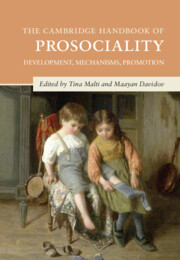Book contents
- The Cambridge Handbook of Prosociality
- Cambridge Handbooks in Psychology
- The Cambridge Handbook of Prosociality
- Copyright page
- Dedication
- Contents
- Figures
- Contributors
- Part I Development of Prosociality
- Part II Antecedents and Mechanisms of Prosociality
- Part III Development of Prosociality in Context
- Part IV Applications
- 26 Fostering Prosociality in the Family Context
- 27 Prosociality and Civic Engagement
- 28 Prosocial Behavior, Positive Youth Development, and Character Virtues
- 29 Relational Practices of Care to Nurture Prosociality and Advance Policy
- 30 Toward a New Era of Prosociality Research
- Afterword
- Index
- References
28 - Prosocial Behavior, Positive Youth Development, and Character Virtues
A Dynamic, Relational Developmental Systems-Based Model
from Part IV - Applications
Published online by Cambridge University Press: 25 May 2023
- The Cambridge Handbook of Prosociality
- Cambridge Handbooks in Psychology
- The Cambridge Handbook of Prosociality
- Copyright page
- Dedication
- Contents
- Figures
- Contributors
- Part I Development of Prosociality
- Part II Antecedents and Mechanisms of Prosociality
- Part III Development of Prosociality in Context
- Part IV Applications
- 26 Fostering Prosociality in the Family Context
- 27 Prosociality and Civic Engagement
- 28 Prosocial Behavior, Positive Youth Development, and Character Virtues
- 29 Relational Practices of Care to Nurture Prosociality and Advance Policy
- 30 Toward a New Era of Prosociality Research
- Afterword
- Index
- References
Summary
No form of biological life exists independent of other lives across its ontogeny. Among humans, mutually beneficial and adaptive (functional) development occurs when (1) an individual acts in ways that contribute to the well-being of the person’s social ecology, including the other individuals in the social world and the social institutions of this context, and (2) the social world supports the positive and healthy development of the individual. Within dynamic, relational developmental systems–based models of human development, these dynamic individual ⬄ individual/social institution relationships constitute adaptive developmental regulations and are the essence of prosociality. We present a dynamic model of the links among prosociality, positive youth development (PYD), and character virtue development. We present the theoretical rationale for the hypothesis that the enhancement of character virtue development through specific character education programs can provide the contextual conditions that, when aligned with an individual’s attributes of thriving, increase the likelihood that PYD and prosociality will be linked among youth.
Keywords
- Type
- Chapter
- Information
- The Cambridge Handbook of ProsocialityDevelopment, Mechanisms, Promotion, pp. 560 - 576Publisher: Cambridge University PressPrint publication year: 2023



